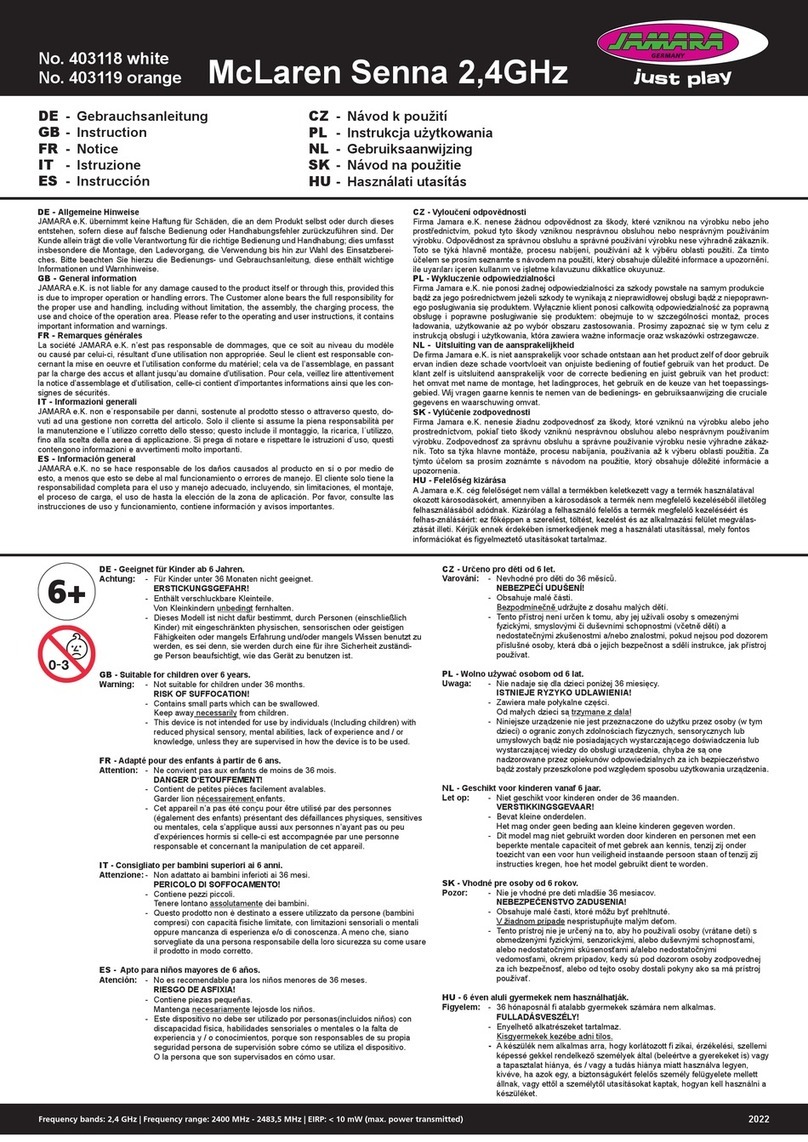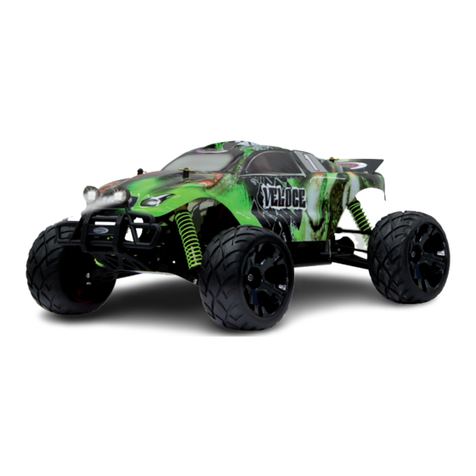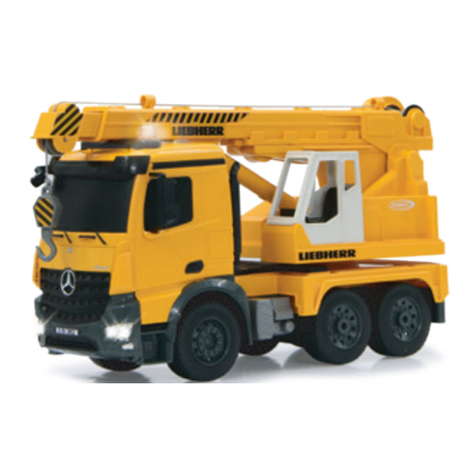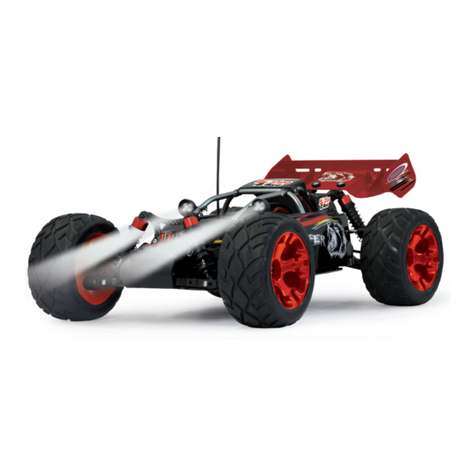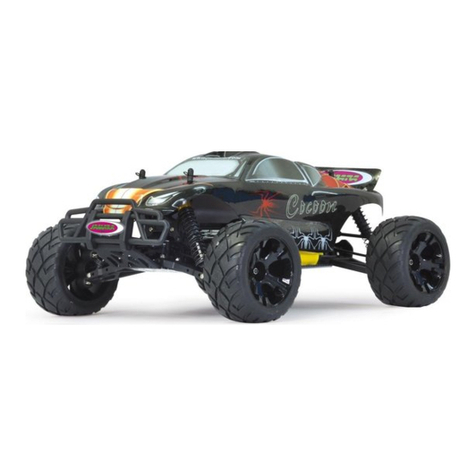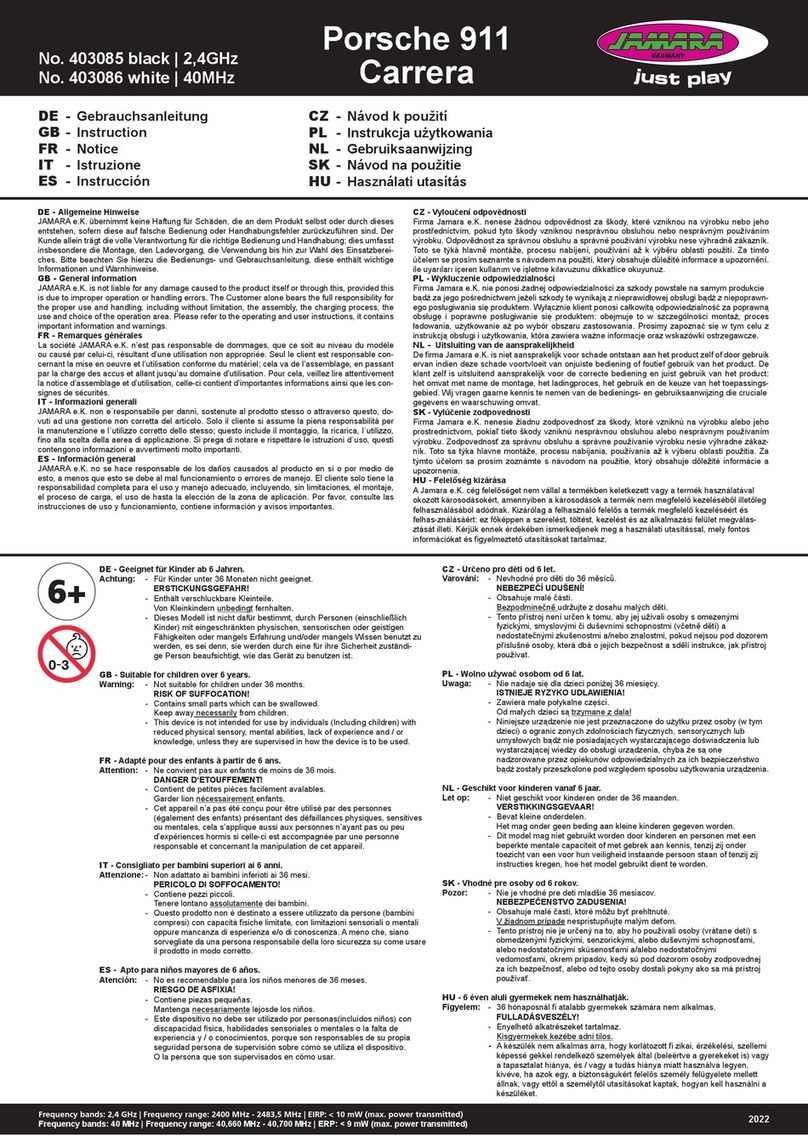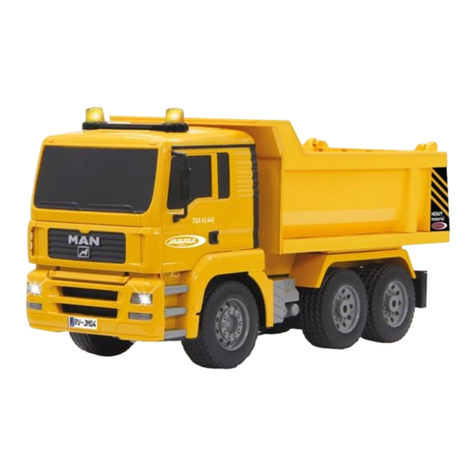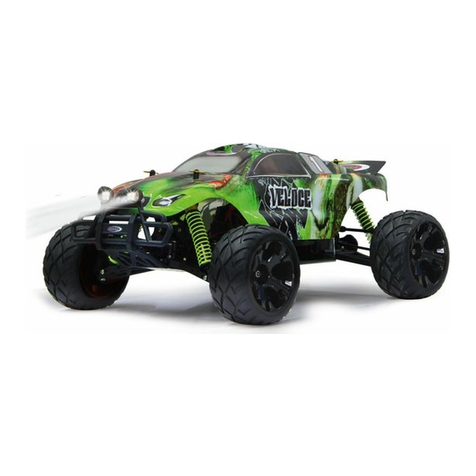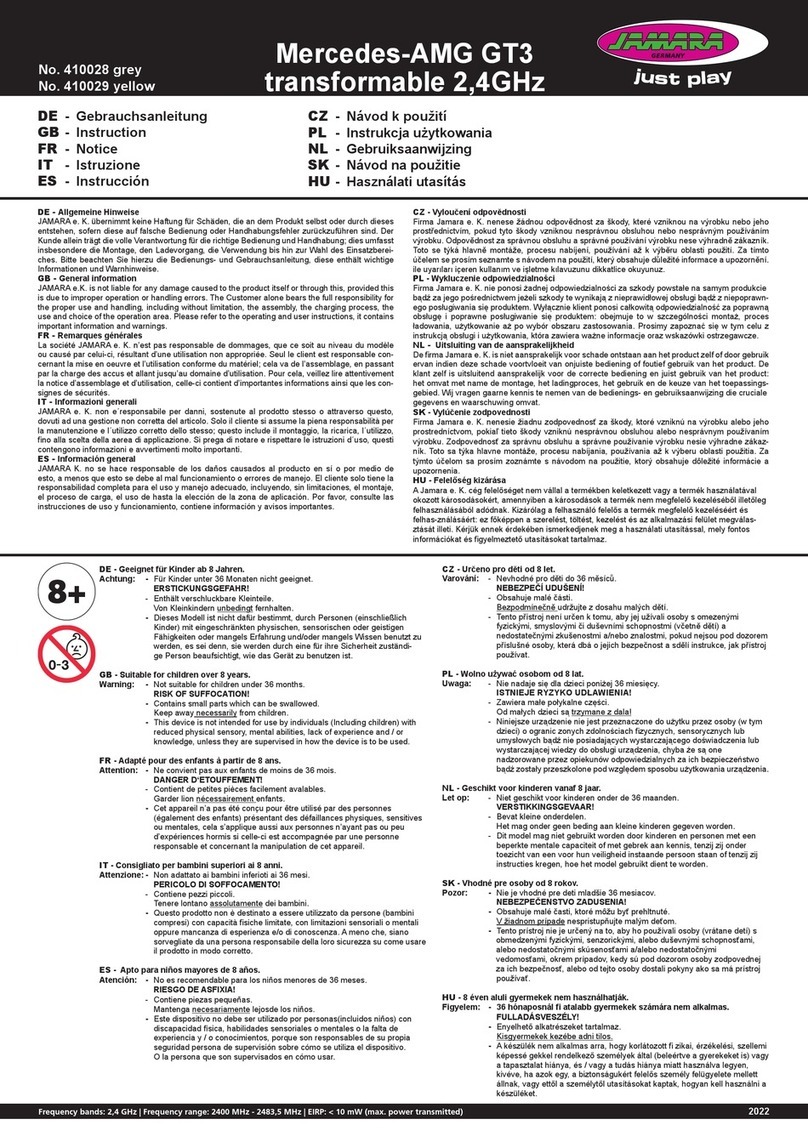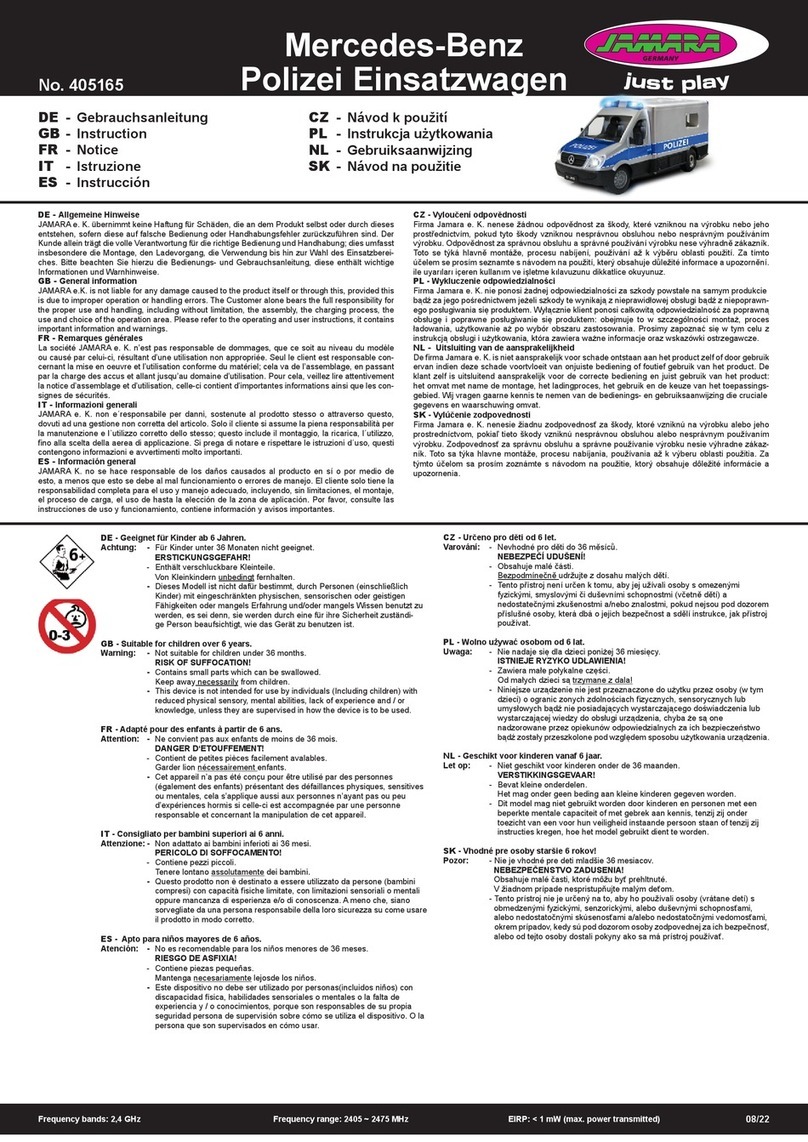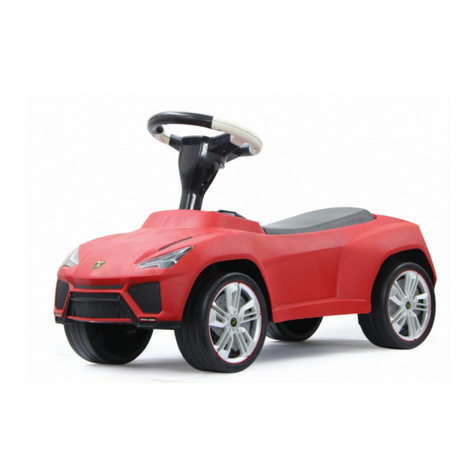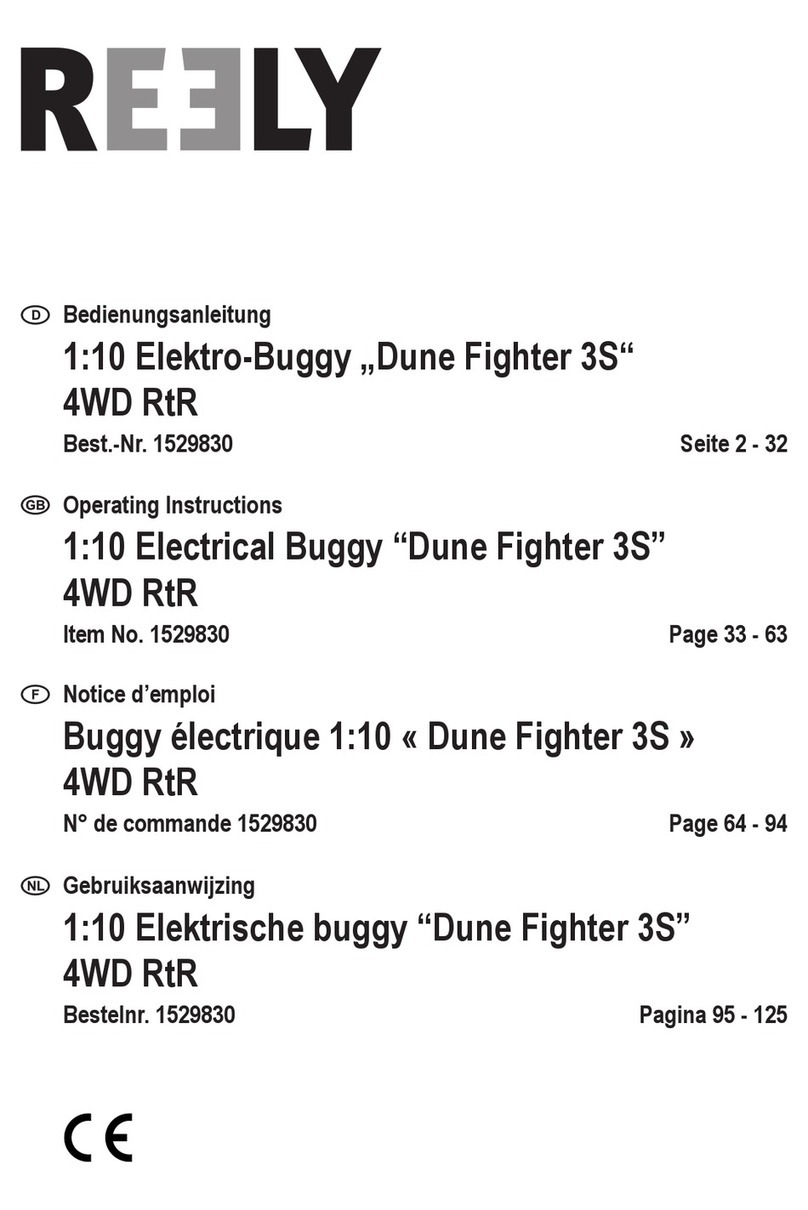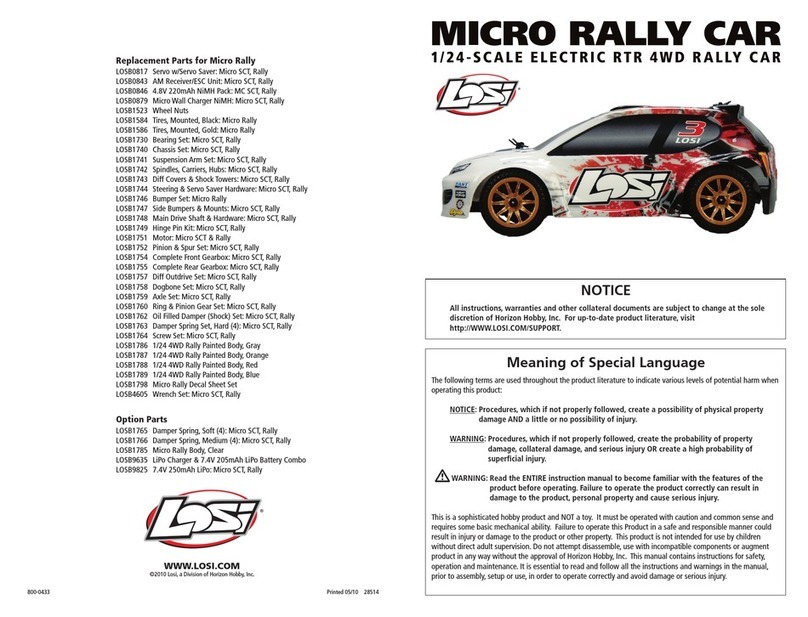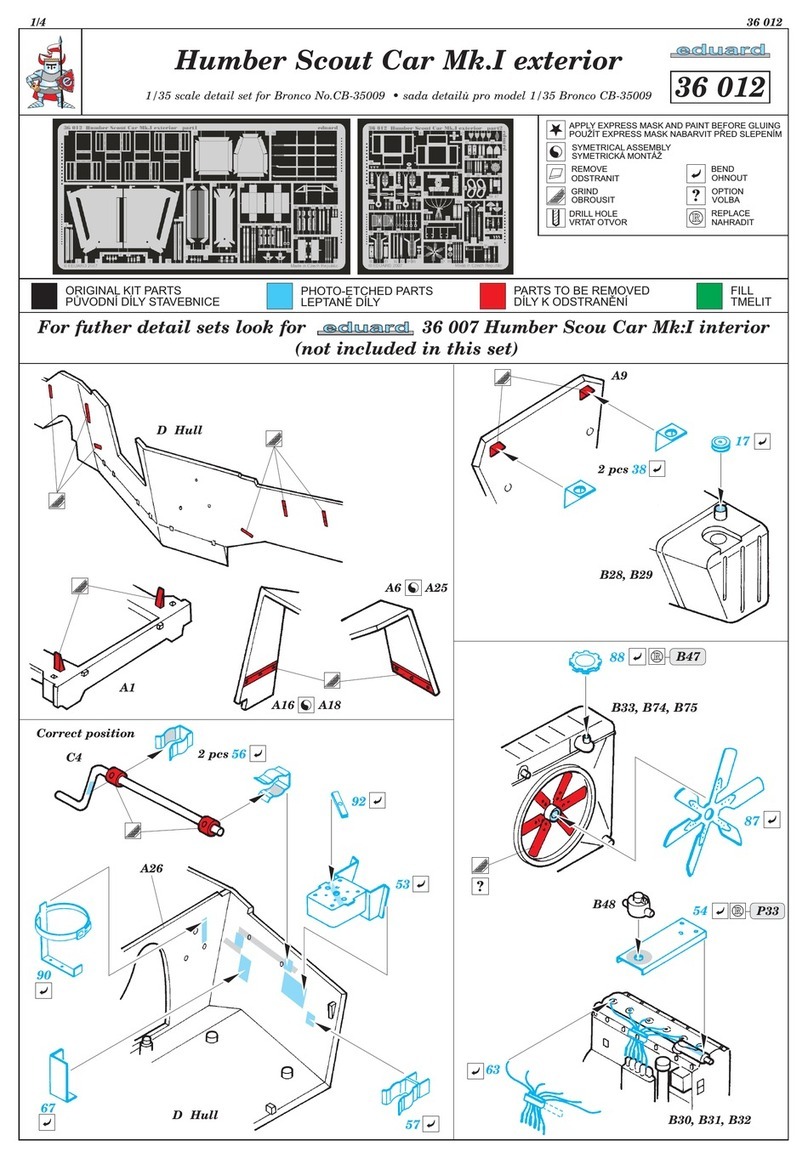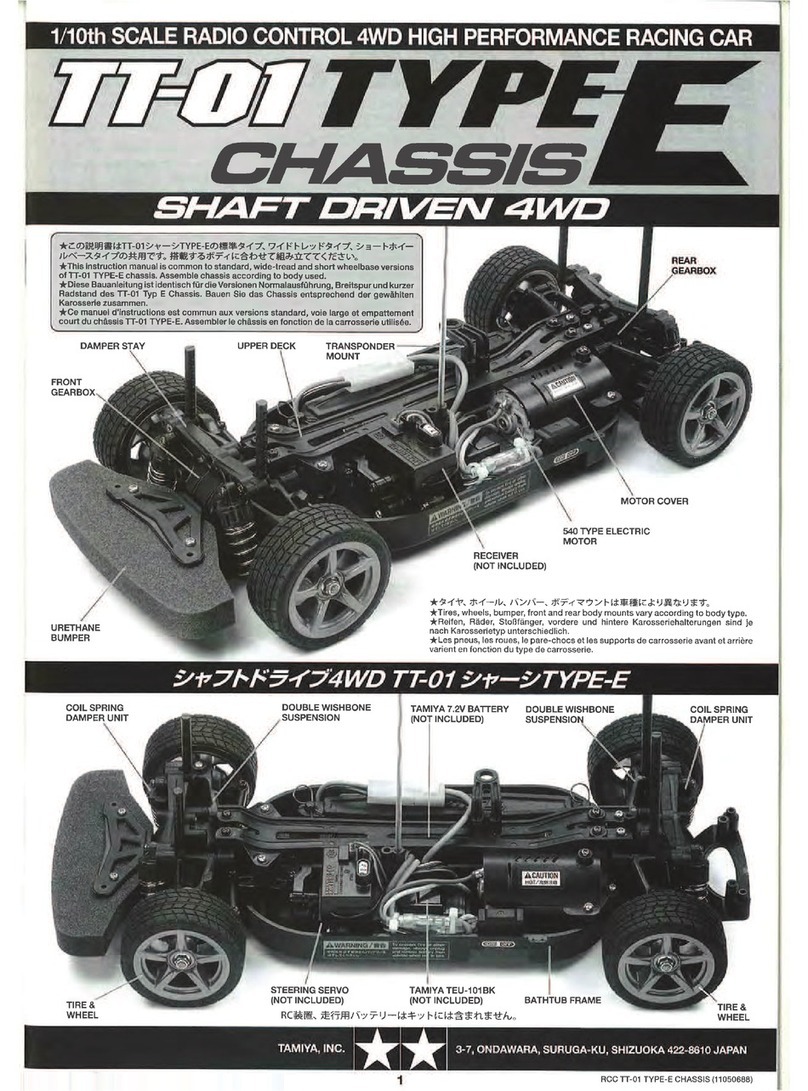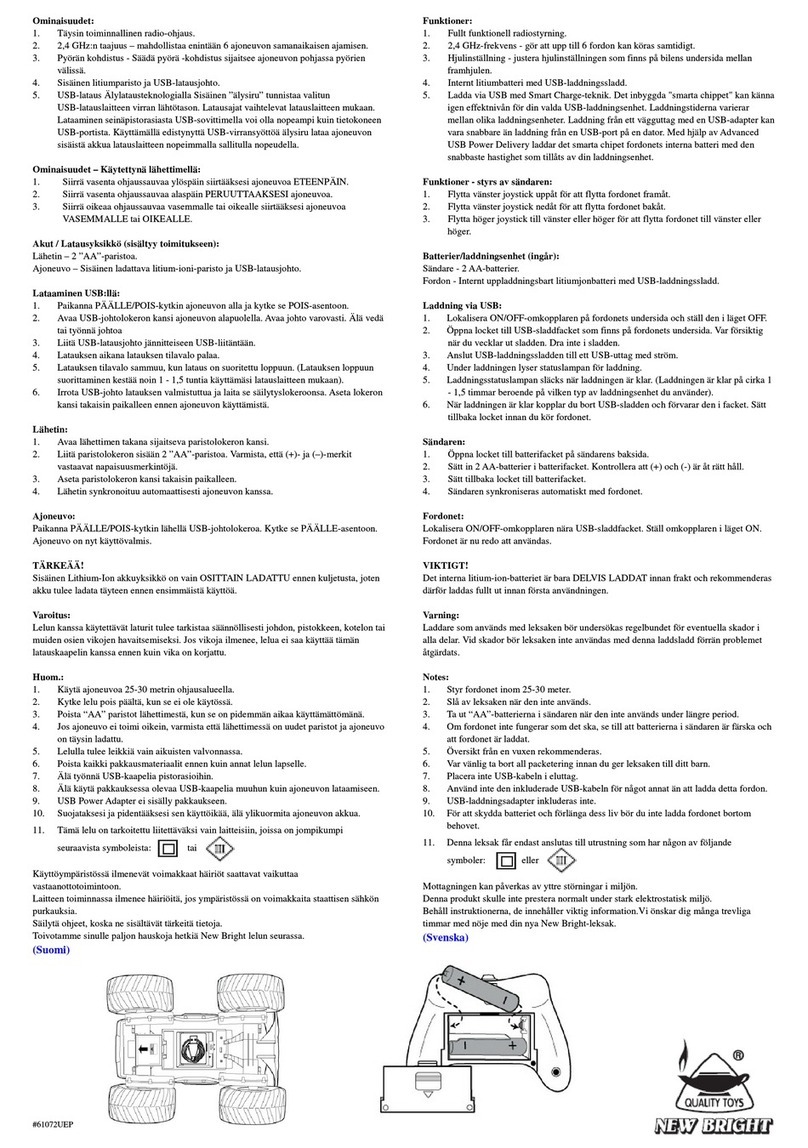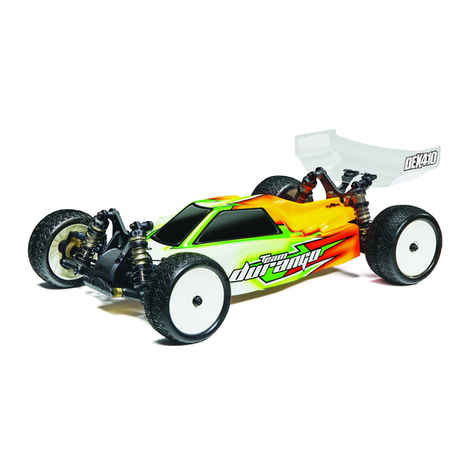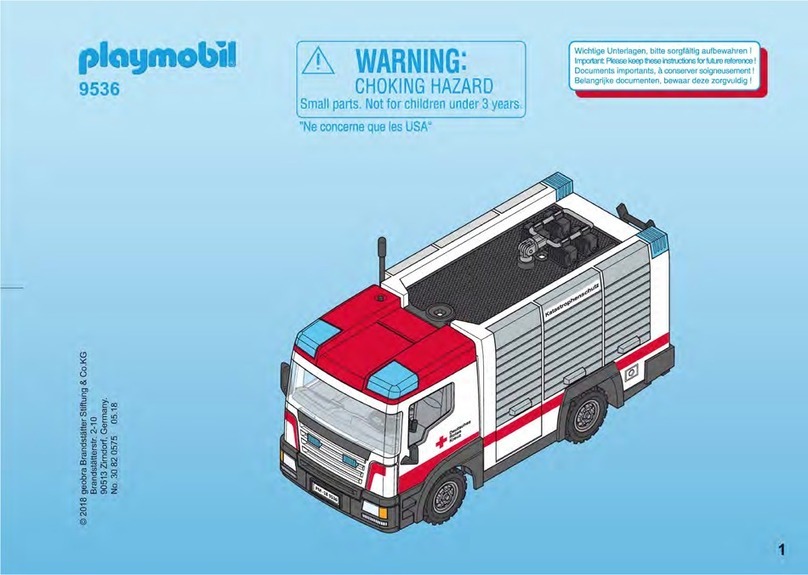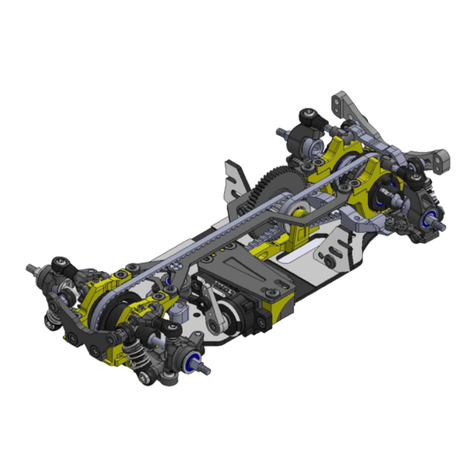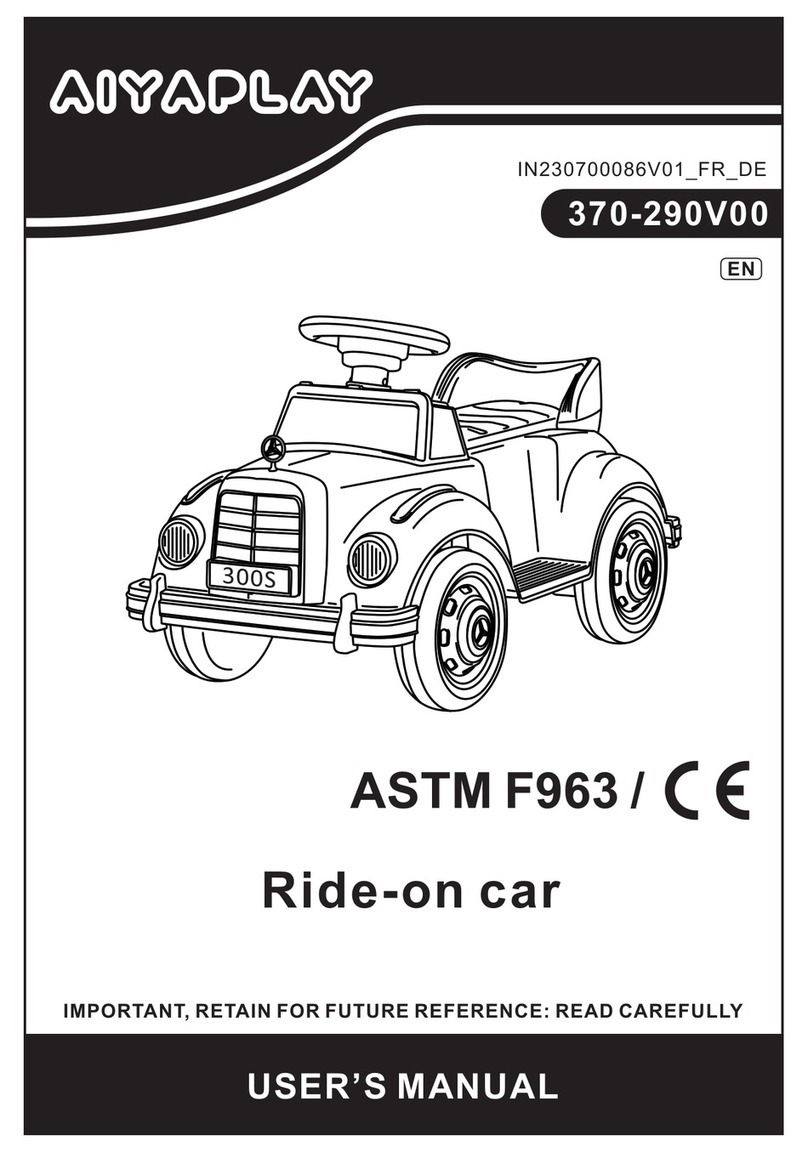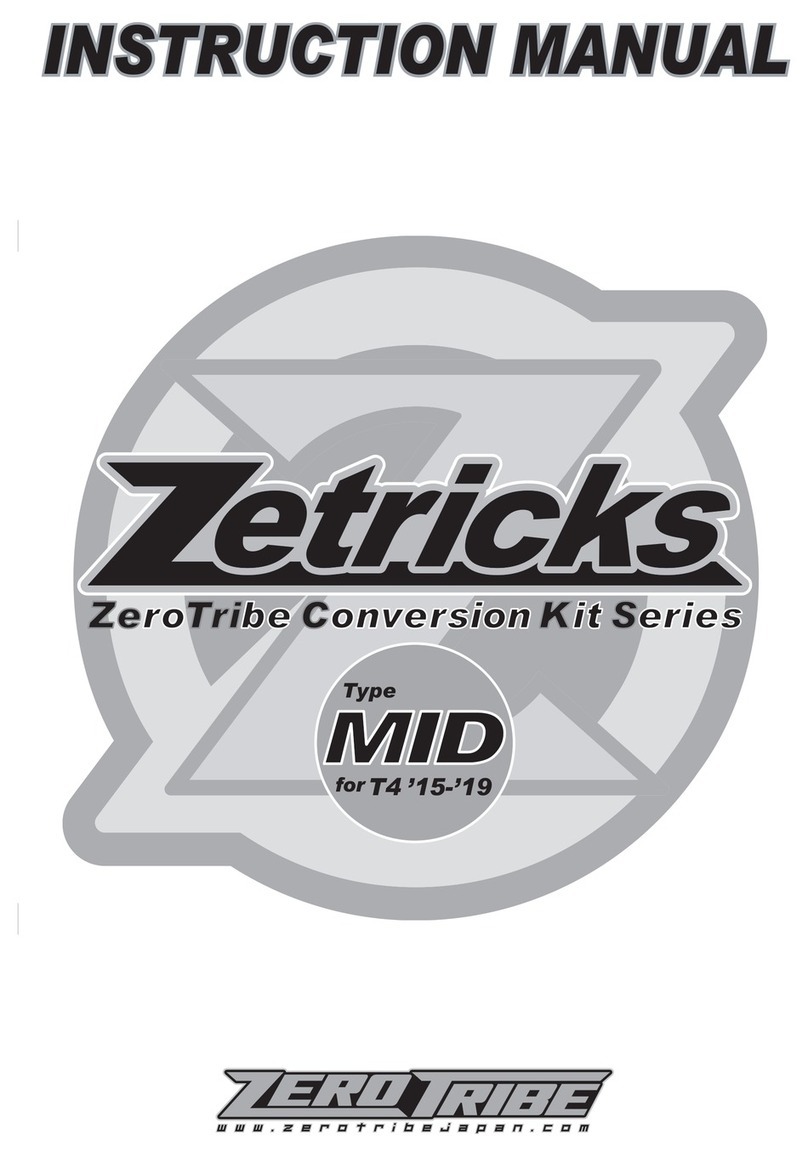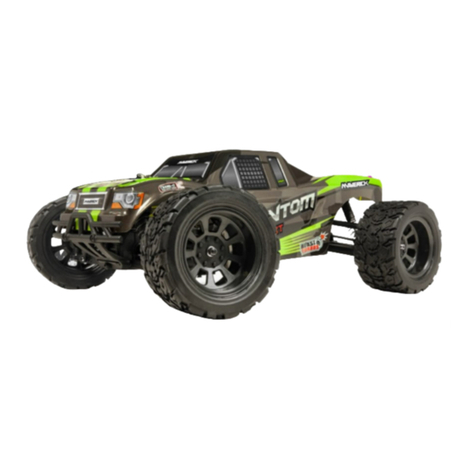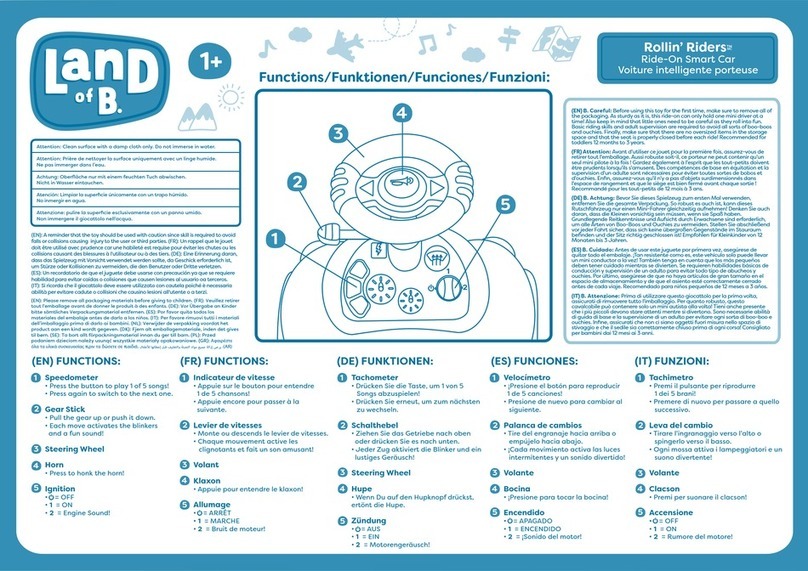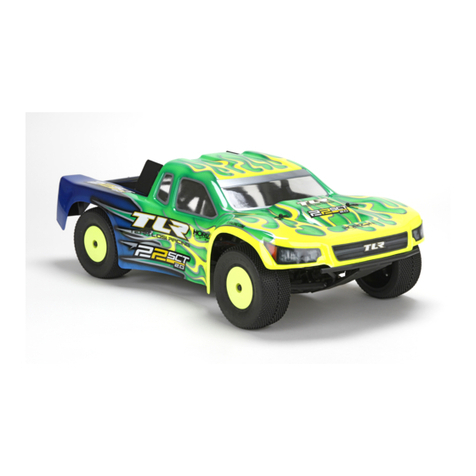
5
C
A
B
D
E
G
H
F
I
6
12
3
4
5
Fail Safe
Setup LED
Programmazione del gruppo integrato di FailSafe
1. Descrizione della Funzione
L’unità FailSafe è concepita principalmente per l‘utilizzo sulle imbarcazioni e sui veicoli. Serve
per evitare la perdita del modello, determinando la chiusura del gas, nell’eventuale assenza
di segnale. Se la ricevente perde il segnale della trasmittente, il servo del gas o regolatore di
velocità ritorna automaticamente sulla posizione programmata inizialmente.
2. Impostazione
a. Accendere la trasmittente
b. Accendere la ricevente. Il segnale LED lampeggia continuamente e indica che la ricevente
è pronta.
c. Spostare sul trasmettitore la leva dell‘acceleratore nella posizione di freno, o zona spento
nel regolatore di velocità. Tenere la leva del gas su questa zona.
d. Premere il pulsante Imposta sul ricevitore. Il segnale LED lampeggia per 3 secondi (vedi
illustrazione a sinistra).
e. L‘impostazione è salvata e si può portare la leva dell’acceleratore in posizione neutra.
3. Prova delle impostazioni
a. Accendere la trasmittente.
b. Accendere la ricevente.
c. Spegnere la trasmittente.
d. Ora la ricevente perde il segnale e conduce il servo del canale gas o il regolatore di veloc
ità sulla posizione in precedenza programmata.
e. Seguire la procedura descritta sopra, il processo FailSafe funziona correttamente.
How to setup the fail safe function
1. The instruction of function
The function of protection of losing control is mainly for r/c boats and cars and keeps them
away from damage through throttle channel. When the receiver is out of control signal, the
receiver of throttle will automatically return to the initial position which set up before starting to
avoid the error action :
2. How to set the function
a. Switch on the transmitter power and enter into the working condition
b. Connect the receiver with power and enter into the working condition, the signal light
on receivewill blink all the time.
c. Control the throttle of transmitter and keeps the servo or ESC in the neutral position.
3. Testing
a. Switch on the transmitter and enter the working condition.
b. Contact the receiver with power and enter the working condition.
d. The throttle of servo will be set automatically.
e. Finish these steps above means the setting is ok.
Trasmittente 2,4 GHz 2CH Transmitter 2,4 GHz 2CH
Vista laterale destra
1. Scatola di programmazione
2. Volante
3. Leva del gas
4. Vano Batterie
5. Presa di carica
6. Collegamentoper cavo Simulatore
Se si carica attraverso una presa, si prega di
aprire il coperchio della batteria. Viene usato
Settore di programmzione
A. Direzione Reverse
B. Power LED
C. Direzione -Trim
E. Gas Reverse
F. Power Check
G. Pulsante collegamen to Binde
H. Dual-Rate
I. Gas Trim
Trim
Se le ruote non puntano dritti in avanti, anche
se il volante della trasmettente è in posizione
neutrale, è possibile ottenere aiuto con il trim
della trasmittente nella posizione corretta.
Trim L/R = Sterzo
Se le ruote girano in avanti o indietro, anche se
nessun comando è stato dato attraverso il tras-
mettitore, poi anche l‘acceleratore deve essere
tagliato sul trasmettitore.
Trim V/R = Avanti / Indietro
Inserimento delle batterie
• Togliere il coperchio del scomparto batterie.
• Inserire 4 x AA batterie nella giusta
posizione, facendo attenzione ai poli.
• Rimettere il coperchio del scomparto
batterie
Controls
1. Programming Box
2. Steering Wheel
3. Throttle Lever
4. Battery Hatch
5. Charge Socket
6. Simulator Cable Socket
If charging the batteries via the charging sock-
et, the battery hatch cover should be removed
Programming Panel
A. Steering Reverse (changed)
B. Power LED
C. Steering Trim
D. ON/OFF Switch
E. Throttle Reverse (changed)
F. Power Check
G. Binding Button
I. Throttle Trim
Trim
If the wheels do not point straight forward even
though the steering wheel on the transmitter is
in neutral, you can adjust it with the trim button
on the transmitter.
Trim L/R = steering
Should the wheels rotate forward or backward,
even though no command was given through
the transmitter, then also the throttle needs to
be trimmed on the transmitter.
Trim V/R = forward/backward
Insert the batteries
• Remove the battery compartment cover.
• Fit the 4 x AA batteries, observe the
correct polarity.
• Replace the battery hatch
2,4 GHz
Antenne
Antenna
Ricevente/Receiver
Allacciare la trasmittente alla ricevente
In un moderno sistema di 2,4 GHz, è indispensabile che la
trasmittente e la ricevente vengano connesse insieme a bordo
del modello. La ricevente accetta quindi solo i segnali della
trasmittente.
allacciamento“connessione”, eseguire le seguenti operazioni:
1. Sostituire nella trasmettente le batterie scariche con altre
cariche o nuove. Lasciare spenta la trasmettente.
2. Inserire la spina di accoppiamento in dotazione nell’uscita
del canale 3.
3. Collegando la batteria con la ricevente, si accende il sistema
ricevente. Secondo la versione di software usata, la
ricevente segnala in modo dierente la modalità di
binding. (esempio: il Led può lampeggiare, restare
accesa o completamente spenta). Il processo di binding in
se è uguale per tutte le versioni. Il Led sulla ricevente inizia
lampeggiare e cosisegnala che la ricevente si trova in
modalità di binding.
4. Tenere premuto il pulsante di connessione sulla
trasmittente, mentre si accende la stessa. E. Il trasmittente
inizia a lampeggiare e cosi segnala che si trova in modalità
di binding.
5. Rilasciare il pulsante di connessione della trasmettente e
rimuovere la spina di connessione nella ricevente.
Spegnere laricevente e la trasmittente.
6. Adesso spegnete la trasmittente. Il sistema memorizza il
collegamento.
7. Installare correttamente tutti gli accessori e controllare con
molta attenzione.
8. Se la funzione non avesse successo, ripetere la procedura
di connessione.
Vi invitiamo ad attivare ora l’unità Failsafe integrata nel ricevitore.
Alla consegna è spento.
Non permettere a nessun oggetto metallico di entrare in contatto
con l‘antenna o di schermarla, poiché ciò ridurrebbe il raggio
d‘azione.
Binding the receiver to the transmitter
In the delivery state, the transmitter is already bound to the re-
ceiver. If the model does not respond to the transmitter, try bind-
ing it again.
For this purpose, proceed as follows:
1. Put the battery into the model.
Now connect the battery to the speed control in the model.
2. Plug the binding plug (included) into the channel 3 socket
on the receiver.
3. Switch the receiver system on. Depending on your soft-
ware version of your receiver indicates the dierent
binding mode (instead of ashing lights for example
LED or remains out completely). The binding process as
indicating that the receiver is in bonding mode.
4. Press and hold down the binding button on the transmitter
whilst switching it on.
5. -
ver is in bonding mode.
the controller. Release the binding plug from the receiver.
7. Switch of the transmitter. And remove the binding wire. The
system be bound at the next start .
8. If the receiver fails to bond or does not function after bond-
ing repeat the above procedure until a successful bonding
is achieved.
We encourage you now to activate your receiver‘s built-in
Failsafe unit. On delivery it is turned o.
Mount the 2.4 GHz antenna vertically as shown in the diagram.
Do not allow any metal object to come into contact with the an-
tenna or to shield it as this will reduce the range.
Spina di
accoppiamento
Binding Plug
